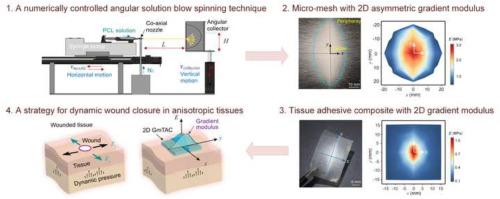Tissue adhesive composite with 2D gradient modulus for effective wound closure on tissue with anisotropic properties
IF 7.7
2区 材料科学
Q1 MATERIALS SCIENCE, COMPOSITES
引用次数: 0
Abstract
Wound closure on tissue with anisotropic elastic modulus in dynamic conditions is challenging. Tissue adhesive hydrogel with homogenous modulus could not effectively prevent wound tear in dynamic conditions, while previously reported tissue adhesive composite with one-dimensional gradient modulus properties was not effective for wound closure on tissue with anisotropic properties. To deal with this issue, this study presents a strategy to design the biocompatible tissue adhesive composite with two-dimensional anisotropic gradient modulus, which is composed of a tissue adhesive matrix and a micro-mesh backbone. A numerically controlled angular solution blow spinning technique was developed to fabricate the micro-mesh with controllable gradient modulus properties. Using the micro-mesh as the backbone, tissue adhesive composite of two-dimensional anisotropic gradient modulus properties (2D A-GmTAC) could be conveniently prepared. Through systematic investigation and simulation, 2D A-GmTAC can effectively prevent wound tear and minimize stress concentration on tissue with tissue with anisotropic elastic modulus, demonstrating superior performance over its counterpart with isotropic elastic modulus properties. This study thus provides an effective solution for the management of challenging wounds on tissue with anisotropic elastic properties in dynamic conditions.

具有二维梯度模量的组织胶粘剂复合材料在具有各向异性的组织上有效地闭合伤口
具有各向异性弹性模量的组织在动态条件下的伤口闭合具有挑战性。具有均匀模量的组织胶水凝胶在动态条件下不能有效地防止创面撕裂,而先前报道的具有一维梯度模量特性的组织胶复合材料在具有各向异性的组织上不能有效地闭合创面。针对这一问题,本研究提出了一种设计二维各向异性梯度模量生物相容性组织胶粘剂复合材料的策略,该复合材料由组织胶粘剂基质和微网骨架组成。为制备具有可控梯度模量特性的微网格,提出了一种数控角解吹丝工艺。以微网为骨架,可以方便地制备具有二维各向异性梯度模量性能的组织胶复合材料(2D A-GmTAC)。通过系统的调查和模拟,2D A-GmTAC可以有效地防止伤口撕裂,并将各向异性弹性模量组织的应力集中降到最低,表现出优于各向同性弹性模量组织的性能。因此,该研究为动态条件下具有各向异性弹性特性的组织的挑战性伤口的处理提供了有效的解决方案。
本文章由计算机程序翻译,如有差异,请以英文原文为准。
求助全文
约1分钟内获得全文
求助全文
来源期刊

Composites Communications
Materials Science-Ceramics and Composites
CiteScore
12.10
自引率
10.00%
发文量
340
审稿时长
36 days
期刊介绍:
Composites Communications (Compos. Commun.) is a peer-reviewed journal publishing short communications and letters on the latest advances in composites science and technology. With a rapid review and publication process, its goal is to disseminate new knowledge promptly within the composites community. The journal welcomes manuscripts presenting creative concepts and new findings in design, state-of-the-art approaches in processing, synthesis, characterization, and mechanics modeling. In addition to traditional fiber-/particulate-reinforced engineering composites, it encourages submissions on composites with exceptional physical, mechanical, and fracture properties, as well as those with unique functions and significant application potential. This includes biomimetic and bio-inspired composites for biomedical applications, functional nano-composites for thermal management and energy applications, and composites designed for extreme service environments.
 求助内容:
求助内容: 应助结果提醒方式:
应助结果提醒方式:


